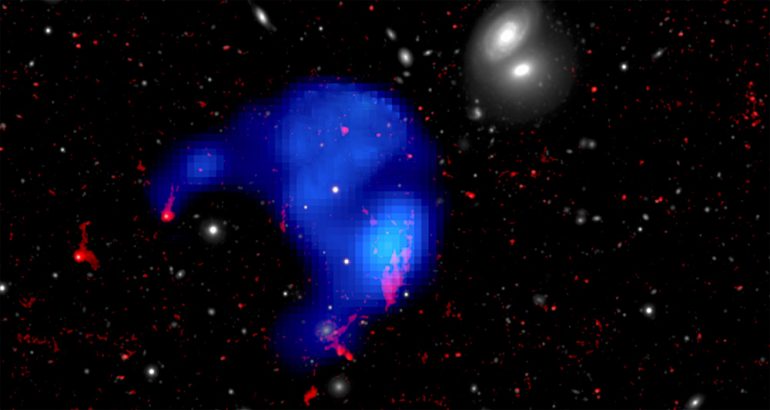The enigmatic giant: A giant gas cloud, not apparently associated with a galaxy, puzzles astronomers. Because the cloud, which is about 300 million light-years away from us, floats in the empty space of a galaxy cluster whose origins cannot be identified. It is also unusual that this hot gas cloud of ten billion solar masses has not yet expanded and cooled. So far astronomers can only speculate about its causes.
They are the raw material for the formation of stars, connecting galaxies as giant filaments and forming the first matter in the young universe: clouds of gas in the universe come in various forms. However, most of the time, they are closely associated with galaxies – either as part of the interstellar matter or as bridges between star clusters.
A gas cloud bigger than the Milky Way
This creates a gas cloud that astronomers discovered in the galaxy cluster A1367, about 300 million light-years away, even more unusual. This group, also known as the Leo Cluster, contains about 70 gravitationally bound galaxies. Chong Ge of the University of Alabama in Huntsville and his colleagues have now discovered something unexpected in the midst of the empty space hissing from these galaxies: a gas cloud floating in the middle of nowhere.
The cloud, which contains hot ionized gas, is about 100,000 light-years in size, making it larger than the Milky Way, according to observations made with the XMM-Newton X-ray Telescope and the European Very Large Telescope (VLT) in Chile. Southern Observatory. Its mass is also considerable: it contains ten billion solar masses – more than many smaller galaxies. Yet there are hardly any stars in the cloud.
Alone in a galaxy-free space
What is special, however, is its isolated position: the cloud is located in the galaxy-free space of the cluster and shows no connection to any star cluster. “This is an exciting and surprising discovery,” says Ges collaborator Ming Sun. Because such “orphan clouds” are extremely rare in galaxy clusters, the researchers explain. Only one such gas cloud is known to date, but it is very small and cold and does not emit X-rays.
This is also strange: Although astronomers estimate that the orphan gas cloud has been floating in space in isolation for several 100 million years, it is still significantly warmer than the normal space medium in galaxy clusters. Their temperature of 10,000 to ten million degrees is similar to that of interstellar matter, as Ge and his team report.
Magnetic field as stabilizer?
So far, astronomers can only speculate about the origin of this distant orphan cloud. Given their temperature, density and direction of motion, they suspect that the orphan cloud came from a galaxy that had once been pulled into the Leo Cluster. When she entered the cluster’s dense, hot atmosphere, a portion of her interstellar gas was pushed back from her. “It’s like our hair and clothes flutter behind us when we run in a strong wind,” Sun explains.
Astronomers had only guessed why the orphan gas cloud had not yet dissipated after millions of years. “This amazing longevity is still poorly understood, but it may have something to do with the magnetic field in the cloud,” Sun says. According to the team’s calculations, a magnetic field of about six micro-gauges could help suppress instability and increase cloud survival in the harsh space environment.
Isn’t that a different matter?
Much of this orphan gas cloud is still puzzling. However, researchers suspect that this is not an isolated case. “This example shows that interstellar matter torn from galaxies can produce clumps in the intracluster medium over a long period of time,” State Ge and colleagues said. Even if this orphan cloud is the first to be detectable in several wave ranges, they consider it very likely that more orphan gas clouds will be discovered in the future. (Monthly Notices of the Royal Astronomical Society, 2021; doi: 10.1093 / manras / chura1569)
Quayle: University of Alabama at Huntsville

Web guru. Amateur thinker. Unapologetic problem solver. Zombie expert. Hipster-friendly travel geek. Social mediaholic.





